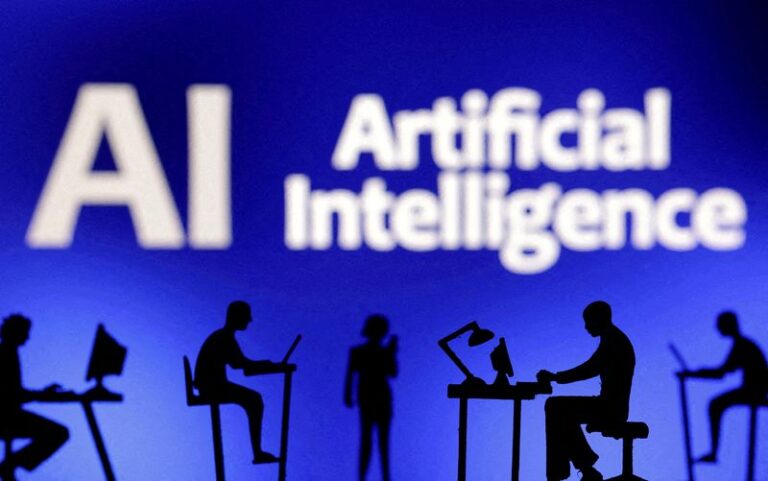By Lewis Krauskopf
NEW YORK (Reuters) – A rally in U.S. stocks fueled by enthusiasm for artificial intelligence is drawing comparisons to the dot-com bubble of two decades ago, raising questions about whether prices have once again been boosted by optimism about a game-changing technology.
AI fever, coupled with a resilient economy and stronger earnings, has propelled the S&P 500 index to new records this year after rising more than 50% from its October 2022 low. The tech-heavy Nasdaq Composite Index has gained more than 70% since late 2022.
While various measures show that stock market valuations and investor exuberance have yet to reach the heights of the turn of the century, the similarities are easy to spot. A small group of massive tech stocks, including artificial intelligence chipmaker Nvidia, epitomizes today’s market, recalling the “four horsemen” of the late 1990s: Cisco, Dell, Microsoft and Intel.
The dizzying run in Nvidia’s shares, which gained nearly 4,300% over a recent five-year period, was reminiscent of how networking equipment maker Cisco surged about 4,500% over the five years before its peak in 2000, according to a comparison of the two stocks by BTIG.
Valuations have also risen, though many tech champions appear to be in much better financial health than their dot-com counterparts of the late 1990s and early 2000s. Other measures, such as investor optimism, have yet to reach the heady heights of the turn of the century.
The fear is that the rise of artificial intelligence will end the same way the dot-com boom did: with a spectacular crash. After nearly quadrupling in just over three years, the Nasdaq Composite plunged nearly 80% from its peak in March 2000 to October 2002. The S&P 500, which had doubled in a similar time frame, collapsed nearly 50% during that period.
While several Internet stocks like Amazon survived and eventually thrived, others never recovered.
“Nobody knows exactly what’s going to happen with artificial intelligence,” said Sameer Samana, senior global market strategist at Wells Fargo Investment Institute, noting the same uncertainty about who the long-term winners might be.
Echoing the dot-com boom, the information technology sector has ballooned to account for 32% of the total S&P 500 market value, the highest percentage since 2000, when it was nearly 35%, according to LSEG Datastream. Three companies alone, Microsoft, Apple and Nvidia, account for more than 20% of the index.
However, technology stocks are now valued more modestly than at the height of the dot-com bubble, trading at 31 times forward earnings, down from 48 times in 2000, according to Datastream.
The difference is evident in the valuations of Nvidia and Cisco, a key supplier of products that support internet infrastructure, whose shares have yet to recover their dotcom boom highs.
While both stocks have soared, Nvidia trades at 40 times forward earnings estimates, compared with 131 times Cisco’s level in March 2000, according to Datastream.
Capital Economics analysts also note that the current rally is being driven more by strong earnings prospects than rising valuations, a sign that fundamentals are more of a driver this time around.
According to an analysis by Capital Economics, forward earnings per share for the sectors that include the current market leaders (technology, communication services and consumer discretionary) have grown faster since the start of 2023 than the rest of the market. In contrast, forward earnings in these sectors grew at a similar pace to the rest of the market in the late 1990s and early 2000s, while their valuations climbed faster than those of other stocks.
More broadly, the S&P 500’s price-to-earnings ratio of 21 is well above its historical average but below the level of around 25 reached in 1999 and 2000, according to Datastream.
“Our base case is that this tech bubble will not burst until the overall market valuation reaches the level reached in 2000,” analysts at Capital Economics said in a note.
Dotcom investors were much more euphoric in some ways. Bullish sentiment in the American Association of Individual Investors’ widely watched survey, often considered a worrying indicator at high levels, reached 75% in January 2000, just months before the market peaked. It recently stood at 44.5%, compared with its historical average of 37.5%.
While an AI bubble is not a foregone conclusion, many investors worry that indicators could become even more stretched in the months ahead if U.S. growth remains robust and tech stocks continue to climb.
“There are a lot of similarities,” said Mike O’Rourke, chief market strategist at JonesTrading. “When a bubble forms, it’s usually rooted in a real positive, fundamental development that gets people excited about paying any price for things.”
(Reporting by Lewis Krauskopf; editing by Ira Iosebashvili and Richard Chang)


